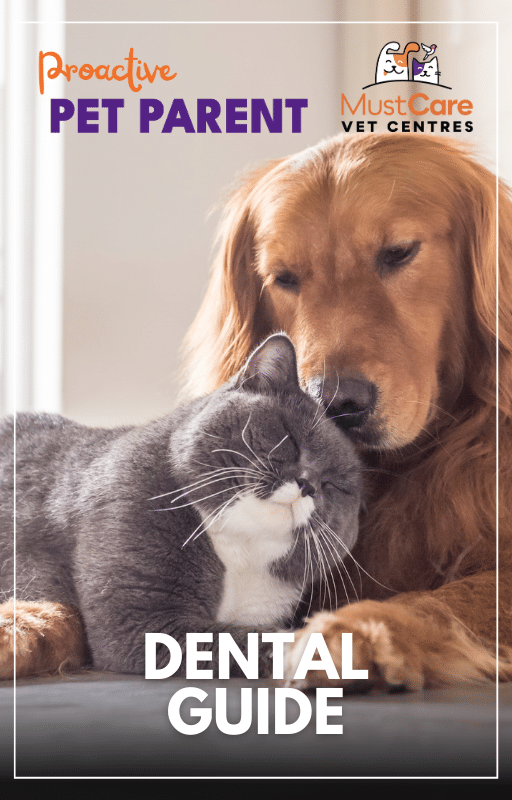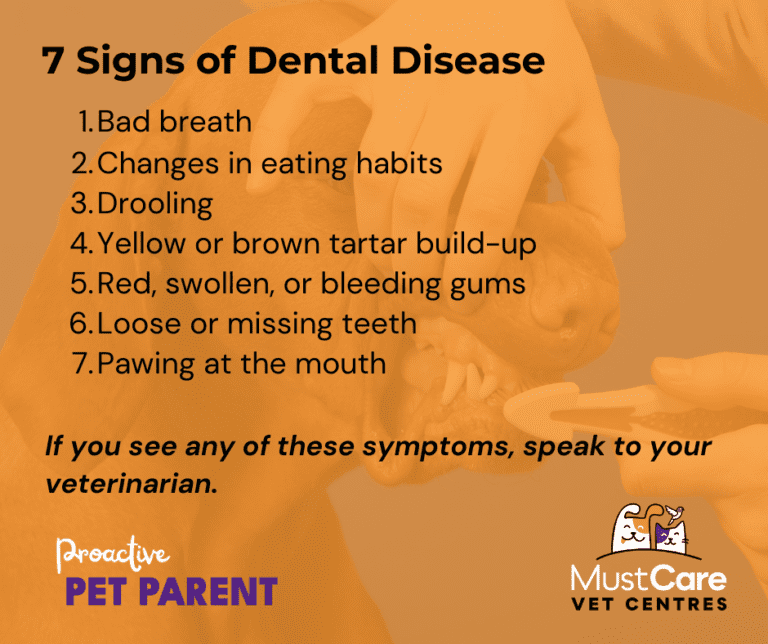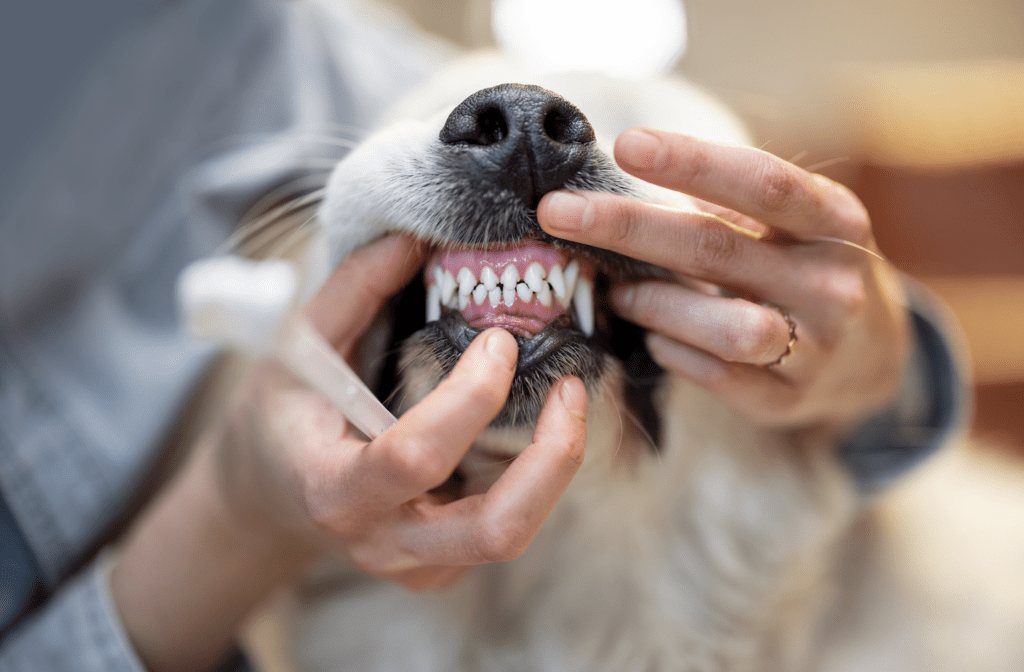Share With Your Friends!
Spotting Trouble Early: 7 Signs of Dental Disease in Dogs
As a pet parent, the well-being of your furry companion is a top priority. But did you know that dental health is often overlooked, despite being a crucial aspect of a dog’s overall well-being?
Many common dental issues start as minor ailments but can escalate quickly if left unattended. The thought of your pet suffering silently from dental discomfort is unsettling. The good news is, early detection can make a significant difference. This article aims to bring about awareness of the early signs of dental disease in dogs to help you identify them before they escalate. Your vigilant observation, paired with professional veterinary care, can help ensure your dog continues to flash that happy, healthy smile for years to come.
What you’ll learn from this blog:
- Understanding the Importance of Canine Dental Health
- The Silent Suffering of Dental Issues in Dogs
- The Connection Between Dental Health and Overall Well-being
- Spotting The 7 Early Signs of Dental Disease
- Interpreting The 7 Early Signs of Dental Disease: What They Mean
- Treatment Options and Preventive Measures
- Empowering Pet Parents for Dental Health
- Daily Routines for Canine Dental Care
- Seek Professional Advice

This blog is part of our Proactive Pet Parent series! This is just the beginning… To see more blogs, click here! Better yet, sign-up to our newsletter to receive these directly to your inbox each month.
Sign-up To The Proactive Pet Parent Newsletter
Understanding the Importance of Canine Dental Health
Amidst the whirlpool of responsibilities ranging from timely vaccinations to providing a nutritious diet, an aspect that often slips through the cracks is dental health for our pets. The topic of dental disease in dogs is not merely a cursory concern but a pressing issue that demands the spotlight. As conscientious pet owners, being attuned to the early signs of dental disease in dogs is imperative.
The Silent Suffering of Dental Issues in Dogs
Our fur-babies communicate in a language of their own. Unlike their human counterparts, dogs may not show their discomfort and as a result they often end up suffering in silence. If left unnoticed or unattended, dental disease can morph into serious health problems. The correlation between dental diseases and other health issues such as heart disease, makes this topic an important one among pet owners and animal healthcare professionals alike.
The Connection Between Dental Health and Overall Well-being
With the rise of Dr Google, today’s pet owners are swamped with a plethora of information. Yet, the clarity on how to discern the early signs of dental disease remains shrouded in medical jargon and fleeting advice. What are the early signs of dental disease? How can I differentiate between normal and abnormal dental conditions? When should I seek professional veterinary care?
These challenges echo a broader societal shift towards informed and responsible pet parenthood. Today’s pet owners are informed and educated – and simply need to turn to Google to find answers to common problems they seek. However, as we’ll find out, dental health isn’t a standalone concern – it’s just one piece of the larger picture of overall pet health. What Dr Google can’t bring, is a vet’s expertise. Years of looking at pet’s teeth and identifying those nasty underlying issues that aren’t easily identifiable with the human eye.
Our aim is to foster a well-informed community of proactive pet owners who are equipped with the knowledge to identify and act upon the initial signs of dental distress in their pets. This knowledge will then pave the way for a pet owners to approach their veterinarian to find out more about canine dental health.
Spotting the 7 Early Signs of Dental Disease
Early detection remains the best defence against dental disease. The subtle signs of dental disease then rests on the keen observation of pet parents. As an advocate for your dog, there are some tell-tail signs to be on the look-out for. The next step is to take action by calling your veterinarian to discuss your concerns.
Some signs to be on the lookout for:
- Bad Breath: While doggie breath may not always smell like roses, an excessively smelly breath could be a sign of dental disease.
- Changes in Eating Habits: A sudden disinterest in kibble (dry food), bones, or even harder chewy treats, or even eating at a slower pace can signal dental discomfort.
- Drooling: While some breeds are prone to drooling, if you notice an uptick in drool, or blood-tinged drool, contact your vet.
- Yellow or Brown Tartar Build-up: A visible tartar accumulation on the teeth, especially near the gum line, is a tell-tale sign.
- Red, Swollen, or Bleeding Gums: Healthy gums are pivotal to dental health. Checking your pet’s gums weekly and taking note of any colour variations is an important step in identifying dental disease.
- Loose or Missing Teeth: Adult dogs should have 42 teeth; missing or loose teeth are red flags.
- Pawing at the Mouth: If your dog is pawing at its mouth or face frequently, it could indicate discomfort.

Interpreting Signs: What They Mean
Each of these signs can be symptoms of an underlying health concern, however it’s important that your veterinarian take the lead in helping you uncover these issues. For instance, bad breath could be a precursor to periodontal disease, a common but serious dental ailment in dogs. The accumulation of bacteria leads to a strong odour which is often the first noticeable sign of a problem. Your veterinarian will be able to undertake diagnostic testing and guide you through the next steps on how to tackle any health issues they find.
Tartar build-up, on the other hand, is a sign you need to visit your veterinarian to have a dental check. When plaque isn’t removed, it hardens into tartar, which requires professional cleaning to remove. Red, swollen gums coupled with yellow or brown tartar may be a sign of dental disease, which requires your veterinarian to detect, and make a plan to tackle those underlying issues.
Loose or missing teeth are often a late-stage symptom of dental disease, which is when the disease has advanced. Early detection and intervention for these issues becomes the key to proactively taking charge for your pet’s overall health and wellbeing.
Treatment Options and Preventative Measures
Treatment options vary widely based on the severity and type of dental disease. They range from professional cleanings and dental exams to more intensive procedures like extractions. Preventive measures such as regular daily brushing of your dog’s teeth, providing dental chews, or investing in dental health-specific diets can reduce the prevelance of dental disease.
Your veterinarian is the best source of information for treatment options. You’ll be looking for a comprehensive plan that lays out your options, the associated financial commitment, and the expected outcomes. Your veterinarian will also continue to work with you at follow-up visits on specialised diets, medications, and routines that will address dental disease.
Empowering Pet Parents for Dental Health
Look for a veterinarian who works to empower you, the pet parent, with the knowledge you need to act in the best interests of your dog. It’s here that we emphasise the importance of the role you play in early detection and intervention. Sitting down with your pooch while they enjoy a meal and observing some of those common signs such as pawing at the mouth, excessive drooling or even refusing food can be the difference between noticing your dog is having dental issues and being unaware, which is when you’ll end up paying for more expensive surgery options down the track.
Daily Routines for Canine Dental Care
The initial steps toward ensuring your furry companion’s dental health are rooted in daily routines. Here’s how you can take the reins and steer away from doggy dental disease:
- Regular Check-ups: Scheduling regular veterinary check-ups, which include dental examinations, is your frontline defence. Professionals can spot and address issues before they escalate.
- Home Dental Care: Incorporating a dental care routine at home is paramount. Brushing your dog’s teeth with canine-specific toothpaste, albeit a seemingly daunting task, is also a necessity for preventive dental care.
- Dental Diets and Chews: Opt for dental diets that are formulated to reduce plaque and tartar build-up. Dental chews can also serve as an effective means to promote dental health while providing an enjoyable activity for your dog.
- Professional Dental Cleanings: When warranted, professional dental cleanings address tartar build-up both above and below the gum line.
- Early Intervention: At the first sign of dental distress, whether it’s bad breath, red gums, or a change in eating habits, seeking professional advice is prudent.
Dealing with the issues of dental disease lies in a blend of professional veterinary care and home-based preventive measures. Recognising the early signs of dental disease, coupled with a routine of undertaking preventive measures recommended by your veterinarian, is what will make you a proactive pet parent… and your dog’s hero!
Seek Professional Advice
Looking after your dog’s dental health may initially seem daunting, yet with the right knowledge, you will be able to tackle any issues of dental disease head-on with your vet. The tell-tale signs of dental distress, be it bad breath, tartar build-up, or a sudden disinterest in food, are not mere standalone issues but signs of underlying dental ailments.
If you spot any signs of dental disease in your dog, be sure to contact the friendly team at MustCare. We’ll talk through your concerns and guide you through the next steps for the best care of your furry pal.

